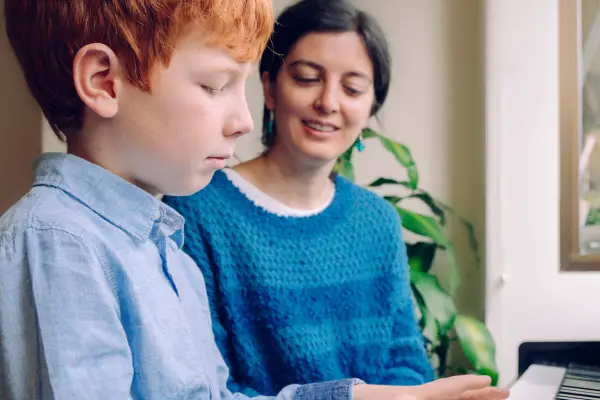Meaningful Conversations About Faith with Kids
Raising children in an interfaith family can provide a beautiful opportunity to expose kids to diverse religions, values and traditions. However, it also comes with unique challenges when it comes to discussing faith. Parents may worry about confusing kids or upsetting family members of different faith backgrounds.
However, having open and thoughtful conversations about faith is key to fostering understanding and respect across religions within your family.
This article will provide tips on when and how to start talking to your kids about faith in an interfaith family. You’ll learn creative ways to teach about your family’s different belief systems.
We’ll also cover how to find common ground while still celebrating the unique aspects of each faith. With understanding and compassion, an interfaith family can gain more than it loses by learning from multiple traditions.
Tips for Meaningful Conversations with Kids
When to Start the Conversations
Some interfaith couples hesitate to discuss faith with their kids, especially when children are very young. However, child development experts recommend introducing the basics starting around age 4.
At this age, kids start noticing religious differences and asking questions. They’re forming their first understanding of the world, so it’s an optimal time to teach the values of respect and inclusiveness.
Aim to frame the conversations to fit your child’s level of cognitive development. For toddlers, focus on explaining rituals and holidays using concrete examples. Preschoolers can grasp basic concepts like God or prayer. Around ages 7-12, kids become able to understand abstract ideas allowing deeper discussions about theology and morality.
Of course, your child may start asking questions earlier depending on their observations of family members’ religious practices. It’s important to honor their curiosity in an age-appropriate way.
For example, telling them “Grandma goes to a special church because she’s Catholic” or “Daddy doesn’t go to temple because he grew up Jewish.” Even if they don’t fully understand, they will absorb the message that there are different ways of believing.

Explaining Family Faith Traditions
When discussing faith with interfaith kids, don’t feel like you need to teach them everything about world religions. Start by focusing on explaining your family’s specific traditions. Here are some tips:
- Share your own experiences growing up: Talk about your family’s religious background and what you learned as a child. Hearing personal stories gives kids context.
- Attend services together: Bringing your child to religious services allows them to observe rituals and ask questions. Explain the meaning behind what they see.
- Involve extended family: Ask grandparents to share holiday traditions or read religious stories. This exposes kids to diverse views within each faith.
- Display religious symbols: Surround kids with representations of different religions through art, books or holiday decorations.
- Celebrate all the holidays: Don’t downplay certain holidays to avoid confusion. Kids can learn to embrace celebrations from multiple faith backgrounds.
The key is creating an environment where kids feel free to express curiosity and ask questions as they observe religious differences. Be open about the idea that various faiths exist without presenting one as “right” or “wrong”.

Teaching Interfaith Values
More important than teaching the tenets of different religions is instilling values of tolerance and mutual understanding in your interfaith children. Here are some principles you can convey:
- People find meaning through faith in different ways: Explain that while belief systems vary, they provide similar moral guidance for how to treat others.
- Faith is highly personal: Make sure kids know their religious identity is a choice they can make for themselves.
- No one knows all the answers about God: Convey your family’s beliefs while allowing for spiritual uncertainty.
- Religions share core values like justice, compassion, and gratitude. Focus on these commonalities.
- Believing differently doesn’t mean disagreement: People can maintain friendship and find common ground across faith lines.
Use teachable moments from everyday life to emphasize values over doctrine. If kids witness interfaith tension, talk through it. Discuss how singular “truths” aren’t possible, but respectful dialogue is.
Navigating Religious Rituals and Holidays
With education, holidays and special events provide an opportunity for interfaith learning. However, they can also bring up challenges around conflicting practices and beliefs. Here are some tips to help kids engage positively:
- Involve kids in all holiday preparations and celebrations. Don’t shy away from certain rituals to avoid confusion.
- Take them to important religious services like Seders, Diwali puja or Christmas mass so they gain exposure.
- Be prepared to discuss symbols and practices. For example, explain that lighting candles represents bringing light into darkness.
- Find ways to repurpose traditions. If Santa isn’t allowed in your Muslim household, have him bring books rather than toys.
- Make new fusion rituals. Light a menorah and say Muslim prayers. Or do an Easter egg hunt with Hindu treats. Blend traditions in creative ways.
- Focus on the values featured in holidays like generosity, service, or sacrifice as common across faiths.
With open communication and adaptability, your family can gain enriching new traditions.

Finding Common Spiritual Ground
An interfaith family has the advantage of tapping into multiple rich spiritual traditions. Here are some ideas for identifying common ground:
- Study sacred texts from both faiths like the Torah, Qur’an and Bhagavad Gita. Note overlapping lessons.
- Learn about universal mystical traditions that connect many faiths through practices like meditation.
- Participate in interfaith prayer services that feature beliefs and music from different religions.
- Identify shared religious values like charity, compassion, or forgiveness to emphasize.
- Note parallels in religious rituals around important life events like birth, adulthood, marriage and death.
- Partake in annual interfaith activities like visiting different houses of worship together.
Drawing connections between religious teachings helps convey an underlying unity across faiths. While theological differences remain, focusing on spiritual commonalities imparts important lessons.
Dealing with External Pressure
Sadly, religious intolerance still exists. Your interfaith family may face criticism or judgement from certain conservative factions. Here are tips on addressing it:
- Discuss any encounters kids have with religious intolerance and reiterate your family’s values.
- Avoid extended family members who refuse to accept your interfaith status if they’re hostile.
- Connect with communities of interfaith families for support. Many large cities have networks and activities.
- Educate your child’s teachers to avoid any religious discrimination from authority figures.
- Consider enrolling kids in interfaith schools or education programs designed to build religious literacy.
With an open and affirming approach, you can nurture interfaith children to become forces for religious tolerance as adults.
Conclusion
Teaching kids about faith in an interfaith home provides a chance to promote religious literacy, compassion and moral reasoning. Maintaining open communication allows children to comfortably explore different rituals and beliefs while forming their own connection to spirituality.
Ultimately, the interfaith approach provides a model of diversity that enriches kids’ understanding of the world. By learning to find the common threads across religions, interfaith families can gain as much or more than those with a single faith tradition.


